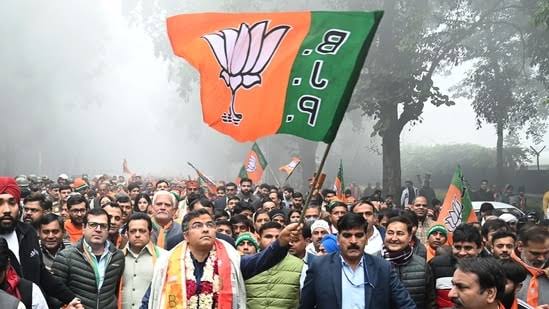The BJP is back with a bang in Delhi, set to form government after 27 years by ousting the Arvind Kejriwal-led Aam Aadmi Party (AAP), which appears to have failed to prove exit poll projections wrong. AAP is poised to bag 22 seats, as per Election Commission of India.
The BJP’s Parvesh Verma turned out to be a giant slayer by defeating Arvind Kejriwal in his New Delhi seat. Kejriwal, battling corruption charges and the ‘Sheesh Mahal’ controversy, won the New Delhi seat for the first time in 2013.
Delhi Assembly election result: 10 Points
Several AAP bigwigs were felled by the BJP. In a major upset, party supremo Arvind Kejriwal was defeated by Parvesh Verma in New Delhi. Kejriwal, who has held the bellwether seat since 2013, lost by 4,089 votes after trailing the ex-MP for the better part of the vote count.
Kejriwal’s former deputy Manish Sisodia conceded to Tarvinder Singh Marwah in Jangpura. After nine rounds of counting, the AAP veteran was trailing by 572 votes. “We fell short by 600 votes. Hope they [BJP] will focus on the progress and welfare of the people,” Sisodia said in his concession speech.
Atishi, who took over as Chief Minister after Kejriwal’s arrest, clawed back a win over BJP’s Ramesh Bidhuri in Kalkaji. Health Minister Saurabh Bharadwaj, after initially leading, lost to saffron party candidate Shikha Roy in Greater Kailash by 3,188 votes.
After 4 hours of counting, AAP’s Patparganj candidate Avadh Ojha, who replaced Manish Sisodia, conceded. Ojha, a popular UPSC coach, was trailing BJP’s Ravinder Singh Negi by over 21,000 votes. “It’s my personal defeat. I couldn’t connect to people… I’ll meet the people and will contest the next election from here,” he told news agency ANI.
The Delhi Assembly elections, held on February 5, witnessed a voter turnout of 60.54 per cent, a decline of about 2.5 percentage points compared to 2020. Mustafabad recorded the highest voter turnout at 69.01 per cent, while Mehrauli saw the lowest turnout at 53.02 per cent, with over 61,000 male and 53,578 female voters.
An average of five exit polls gave the BJP 39 seats, comfortably past the 36-seat majority mark. AAP was projected to win 30 seats, a sharp decline from 62 in 2020. The Congress, which failed to win any seats in the last two elections, was predicted to secure 1-2 seats.
During the campaign’s final stretch, political tensions boiled over when AAP accused the BJP-led Haryana government of “poisoning Yamuna water,” leading to sharp exchanges between the two parties.
Voters in Delhi weighed everyday issues like water, drainage, and garbage against a high-voltage campaign. The BJP’s relentless focus on Arvind Kejriwal’s lavish bungalow renovation—dubbed “sheesh mahal”—and corruption allegations swayed public opinion of the AAP, which came to power on an anti-graft plank.
AAP, reeling from Kejriwal and Manish Sisodia’s arrests in the excise policy case, pushed back, blaming interference from Lieutenant Governor VK Saxena for governance hurdles. But the defence failed to gain traction.
With the defeat in Delhi, its stronghold for a decade, AAP is staring at an existential crisis. The debilitating loss could shatter the party’s national ambitions, leaving Punjab as its last bastion.



